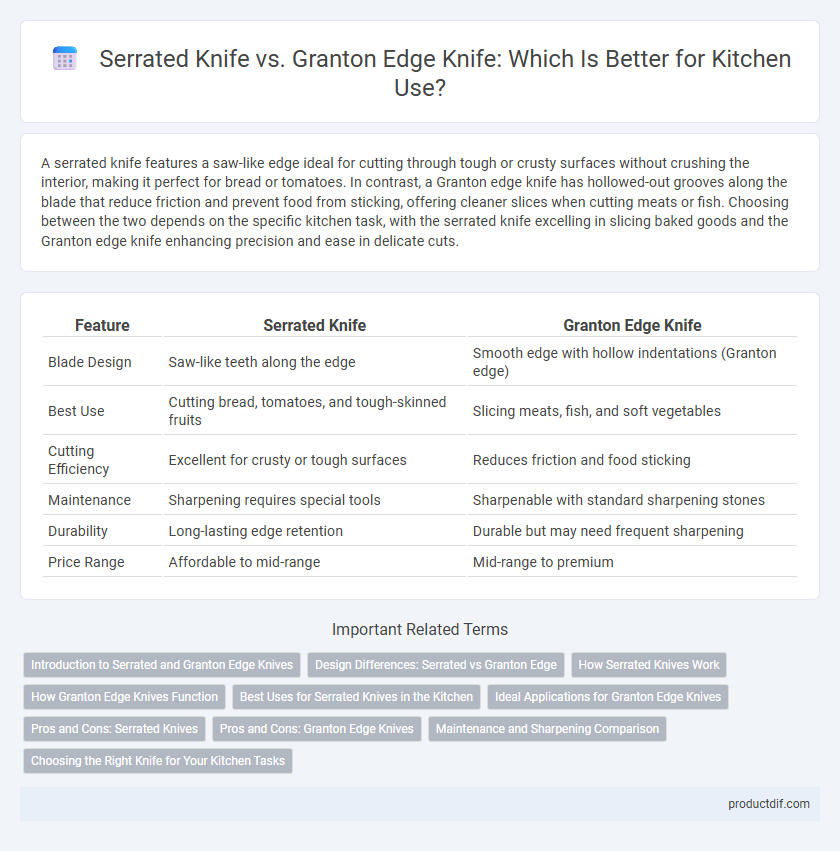A serrated knife features a saw-like edge ideal for cutting through tough or crusty surfaces without crushing the interior, making it perfect for bread or tomatoes. In contrast, a Granton edge knife has hollowed-out grooves along the blade that reduce friction and prevent food from sticking, offering cleaner slices when cutting meats or fish. Choosing between the two depends on the specific kitchen task, with the serrated knife excelling in slicing baked goods and the Granton edge knife enhancing precision and ease in delicate cuts.
Table of Comparison
| Feature | Serrated Knife | Granton Edge Knife |
|---|---|---|
| Blade Design | Saw-like teeth along the edge | Smooth edge with hollow indentations (Granton edge) |
| Best Use | Cutting bread, tomatoes, and tough-skinned fruits | Slicing meats, fish, and soft vegetables |
| Cutting Efficiency | Excellent for crusty or tough surfaces | Reduces friction and food sticking |
| Maintenance | Sharpening requires special tools | Sharpenable with standard sharpening stones |
| Durability | Long-lasting edge retention | Durable but may need frequent sharpening |
| Price Range | Affordable to mid-range | Mid-range to premium |
Introduction to Serrated and Granton Edge Knives
Serrated knives feature a scalloped edge ideal for slicing through tough surfaces like bread crusts and tomatoes without crushing the interior. Granton edge knives have hollowed-out grooves along the blade, reducing friction and preventing food from sticking during slicing. Both knife types enhance precision and efficiency but are designed for distinct cutting tasks in the kitchen.
Design Differences: Serrated vs Granton Edge
Serrated knives feature a saw-like edge with sharp teeth that excel at cutting through tough or crusty surfaces, making them ideal for bread and tomatoes. Granton edge knives have a smooth, straight blade with hollowed-out grooves along the sides that create air pockets to reduce friction and prevent food from sticking, enhancing slicing efficiency. The primary design difference lies in the serrated blade's aggressive tooth pattern versus the Granton blade's smooth edge with scalloped indentations for versatile, precision cutting.
How Serrated Knives Work
Serrated knives feature a scalloped, saw-like edge designed to grip and slice through tough or fibrous surfaces such as crusty bread or tomatoes without crushing them. The pointed teeth of a serrated blade create multiple contact points that initiate cuts with precision, making them ideal for tasks requiring controlled sawing motions. Their unique edge structure maintains sharpness longer than straight-edged knives, especially when cutting through foods with hard exteriors and soft interiors.
How Granton Edge Knives Function
Granton edge knives feature scalloped depressions along the blade that create air pockets, reducing friction and preventing food from sticking during slicing. This design improves efficiency and provides cleaner cuts, especially with softer or moist ingredients like fish and vegetables. Unlike serrated knives, which use saw-like teeth to cut through tough surfaces, Granton edge knives deliver smoother, precise slicing ideal for delicate tasks.
Best Uses for Serrated Knives in the Kitchen
Serrated knives excel at slicing through foods with tough exteriors and soft interiors, such as bread, tomatoes, and citrus fruits, without crushing them. Their saw-like edges maintain sharpness longer, making them ideal for cutting crusty bread, cakes, and delicate pastries. These tools are essential for precision tasks where clean, effortless cuts are needed on textured or slippery surfaces.
Ideal Applications for Granton Edge Knives
Granton edge knives feature scalloped indentations along the blade, reducing friction and preventing food from sticking, making them ideal for slicing delicate items such as smoked salmon, roasted meats, and soft cheeses. Their design enhances precision and efficiency in cutting tasks that require thin, clean slices without crushing the food. This makes Granton edge knives a preferred choice in professional kitchens for preparing visually appealing dishes and maintaining texture integrity.
Pros and Cons: Serrated Knives
Serrated knives excel at cutting through tough, crusty bread and fibrous vegetables due to their saw-like teeth, which grip and slice efficiently without crushing the food. Their primary drawback is difficulty in sharpening, resulting in a blade that may become less effective over time without professional maintenance. These knives are less versatile than Granton edge knives and can cause uneven cuts on delicate ingredients.
Pros and Cons: Granton Edge Knives
Granton edge knives feature scalloped indentations along the blade that create air pockets, reducing food adhesion and allowing for smoother, thinner slices, making them ideal for delicate meats and fish. They offer superior slicing precision and minimize food sticking, but their specialized design can make sharpening more challenging and may not be as versatile for tougher cutting tasks compared to serrated knives. While Granton edge knives excel in fine slicing and presentation, they require careful maintenance and are less effective for cutting hard or crusty foods where serrated knives perform better.
Maintenance and Sharpening Comparison
Serrated knives require less frequent sharpening due to their scalloped edges, but maintaining their sharpness demands specialized tools like ceramic rods or serrated knife sharpeners. Granton edge knives, known for their hollowed grooves that reduce food sticking, need regular honing with a fine steel and occasional professional sharpening to preserve their smooth, straight blade. Proper maintenance of both knife types enhances cutting efficiency and prolongs blade lifespan in kitchenware.
Choosing the Right Knife for Your Kitchen Tasks
Serrated knives excel at cutting through tough, crusty bread and fibrous vegetables due to their saw-like edges that grip and slice with precision. Granton edge knives feature scalloped indentations along the blade that reduce friction and prevent food from sticking, making them ideal for slicing delicate meats and fish. Selecting the right knife depends on your primary kitchen tasks: opt for serrated knives for bread and hard-skinned produce, while Granton edge knives are preferable for clean, smooth cuts of protein and soft fruits.
Serrated Knife vs Granton Edge Knife Infographic

 productdif.com
productdif.com